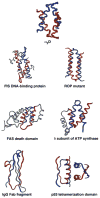De novo design of helical bundles as models for understanding protein folding and function
- PMID: 11087311
- PMCID: PMC3050006
- DOI: 10.1021/ar970004h
De novo design of helical bundles as models for understanding protein folding and function
Abstract
De novo protein design has proven to be a powerful tool for understanding protein folding, structure, and function. In this Account, we highlight aspects of our research on the design of dimeric, four-helix bundles. Dimeric, four-helix bundles are found throughout nature, and the history of their design in our laboratory illustrates our hierarchic approach to protein design. This approach has been successfully applied to create a completely native-like protein. Structural and mutational analysis allowed us to explore the determinants of native protein structure. These determinants were then applied to the design of a dinuclear metal-binding protein that can now serve as a model for this important class of proteins.
Figures








References
-
- Cordes MHJ, Davidson AR, Sauer RT. Sequence space, folding and protein design. Curr Opin Struct Biol. 1996;6:3–10. - PubMed
-
- Dill KA. Dominant forces in protein folding. Biochemistry. 1990;31:7133–7155. - PubMed
-
- Dobson CM. Characterization of protein folding intermediates. Curr Opin Struct Biol. 1991;1:22–27.
-
- Eaton WA, Thompson PA, Chan CK, Hagen SJ, Hofrichter J. Fast events in protein folding. Structure. 1996;4:1133–1139. - PubMed
Publication types
MeSH terms
Substances
Grants and funding
LinkOut - more resources
Full Text Sources
Other Literature Sources

